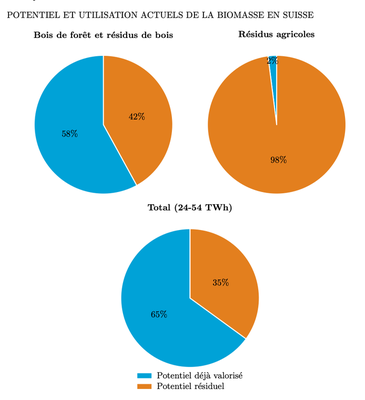Is the sustainable potential of biomass in Switzerland being fully exploited?
Switzerland has a sustainable biomass potential estimated at about 10% of its primary energy needs. Today, only half of this potential is actually exploited.
Biomass comprises all resources of plant origin (wood, grass, agricultural residues, vegetable oils, algae, etc.) and animal origin (liquid manure, slurry, sludge from sewage plants, etc.). All forms of biomass can be used for energy production. This is called “bioenergy”. Wood, in particular, played a key role in heating and cooking for millennia until the Industrial Revolution. It was not until the beginning of the 20th century that biomass was supplanted by fossil fuels, which are cheap, easy to handle and have a much higher energy density. Today, biomass covers only 10% of the world’s energy demand, but is still by far the most important source of renewable energy.
By 2018 in Switzerland, biomass will account for only 5% of our energy supply, far behind hydropower (16%), but well ahead of other renewable energy sources [→ Q47], and less than 1% of our net electricity production. By comparison, Austria, which has a similar topography and forest cover to Switzerland, covers almost 17% of its primary energy needs with indigenous biomass.
The total sustainable potential of biomass in Switzerland is estimated to be between 24 and 36 TWh of primary energy. Most of this potential (12 TWh) comes from wood (forest wood and wood residues). Agricultural residues account for 6 TWh, and biogenic waste (sludge from sewage plants and the biomass fraction of our household waste, etc.) about 5 to 7 TWh. More recent estimates echo these estimates. The theoretical potential is in the order of 60 TWh of primary energy, with about half (30 TWh) from wood and a quarter from biogenic waste (14 TWh), and the sustainable potential is roughly halved.
Dedicated energy plants, however, represent only a limited potential. Today, we use only half of our sustainable biomass potential. Forest wood, pruning residues and animal excreta (manure) remain under-exploited, while the potential of biogenic waste and wood residues (sawdust, reclaimed wood, etc.) seems already exhausted [→ see figure below].
The portion of our sustainable biomass potential that can actually be exploited will essentially result from market prices for biomass. Biomass has a unique feature among renewable energy sources: it is the only one that has a price. Wind, solar radiation, geothermal energy, river water and environmental heat are indeed “free” resources, whereas biomass is traded on markets with fluctuating prices. The development of bioenergy will therefore depend crucially on the economic competitiveness of biomass.
Switzerland’s rugged topography and high labour costs currently limit the economically exploitable potential of Swiss biomass. This explains why we currently import more than 36,000 tonnes of wood pellets per year, which represents 5% of our biomass consumption. The higher the overall market prices for biomass (which is a widely observed trend as a result of increasing global demand), the more economically we will be able to exploit our domestic resources. We can reasonably estimate that by 2050 we will be able to develop our entire biomass potential.
Unlike solar, wind or geothermal energy, biomass is a renewable energy source whose sustainability is not self-evident. In recent years, the social and environmental sustainability of the various bioenergy sectors has become a hot topic. Scepticism is growing about the greenhouse gas reduction potential of first-generation biofuels (based on cereals, vegetable oils, or sugar plants). More general concerns persist about other environmental and social impacts, such as competition with food agriculture, impact on biodiversity, water scarcity and land use change. In Switzerland, however, legal safeguards are sufficient to ensure that biomass remains sustainably managed, but we will need to keep a close eye on our imports, especially biofuels from abroad [→ Q56].
Managed in a sustainable way, however, biomass energy production has many advantages. First, biomass is versatile since it is used for electricity, heat or fuels [→ Q55]. Second, final energy production from biomass is not dependent on weather conditions (unlike wind or solar). Finally, this form of energy production has an undeniable ecological advantage in that it closes the material cycle; biomass is primarily used for the production of food or building materials. It is usually only the waste or by-products resulting from this use that are then recovered for energy purposes.

References
- Office fédéral de l'énergie (OFEN) (2019)
- Office fédéral de l'énergie (OFEN) (2019). Statistique globale de l’énergie 2018. OFEN.
- Office fédéral de l'environnement (OFEV) (2009)
- Office fédéral de l'environnement (OFEV) (2009). Biomasse: la Suisse se fixe des objectifs stratégiques.
- Steubing, B and Zah, R and Waeger, P and Ludwig, C (2010)
- Steubing, B and Zah, R and Waeger, P and Ludwig, C (2010). Bioenergy in Switzerland: assessing the domestic sustainable biomass potential. Renewable and Sustainable Energy Reviews, 14(8). 2256–2265.